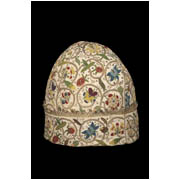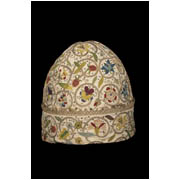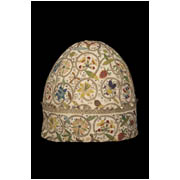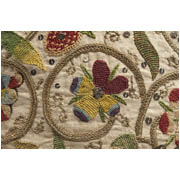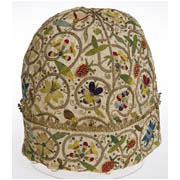Details
- Object type
cap; nightcap
- Place Associated
England (place of manufacture)
- Date
circa 1600-1620
- Materials
linen, silk, silver-gilt
- Dimensions
overall: 180 mm x 180 mm x 180 mm
- Description
-
Man's cap or nightcap in linen embroidered with black, blue, green, pink, purple, red and yellow silk and silver-gilt threads worked in corded detached buttonhole, buttonhole, chain and reverse chain stitch decorated with silver-gilt spangles with a rinceau design of coiling stems and flowers, including daffodils, roses, pansies and honeysuckle as well as grapes, strawberries and acorns. Cut in one panel with four conical sections along top forming high crown with the pattern duplicated on each and lower edge turned back to form brim edged with silver-gilt bobbin lace decorated with silver-gilt spangles.
Traditionally plain linen nightcaps were worn in bed at night. However, at the end of the 1500s and into the early 1600s embroidered nightcaps became popular. In keeping with their use as informal wear embroidered nightcaps are only depicted in a few portraits of this period. It was generally only academics and members of the clergy who were shown wearing nightcaps as a signifier of their profession. An unusual inclusion of a richly embroidered nightcap is in the portrait, British School, Phineas Pett (1570–1647), circa 1612, (National Portrait Gallery, London). Pett was neither a scholar nor a clergyman, but a Master Shipwright at Chatham. His decision to be depicted wearing a nightcap reflects a pretentious aspect of his character, alluding to a level of scholarship he did not have. His awareness of the significance of dress as an outward sign of importance is apparent in his autobiography in which he wrote that despite his limited income he was ‘contented to taken any pains to get something to apparel myself, which by God’s blessing I performed before Easter next after, and that in very good fashion, always endeavouring to keep company with men of good rank far better than myself’.
The pattern of flowers within coiling stems was very popular in the 1590s to 1620s and was used for waistcoats as well as nightcaps and coifs. The flowers were copied from botanical prints and were often used to symbolise different personality traits. One of the flowers on this nightcap is the pansy, commonly known as heart’s-ease, which was a popular motif appearing on waistcoats, nightcaps, coifs and gloves. It was a favourite flower of Queen Elizabeth I of England. When Elizabeth Talbot (1521–1608), Countess of Shrewsbury, sought advice in 1575 as to what would be a suitable New Year’s gift for the monarch she was advised by Frances Radclyffe (1531–89), Countess of Sussex, to embroider a cloak with pansies as ‘ye queen likes byst off that floware’. Their name is said to have derived from the French term pensée meaning ‘to think’ and the flowers were often used to symbolise kind thoughts. The forsaken Ophelia in William Shakespeare, Hamlet, circa 1599-1601, gives the flower to her brother Laertes saying ‘There’s rosemary, that’s for remembrance. Pray you, love, remember. And there is pansies, that’s for thoughts.’ Honeysuckles were associated with affection and fidelity.
As well as being decorated with floral motifs nightcaps could also be scented with flowers and herbs. William Turner, A Newe Herball, 1551, ‘judge[s] that the flowers of the Lavender ‘quilted in a cap and dayly worne are good for all diseases of the head that do come of a cold cause and they comfort the braine very well’.
Provenance: Frank Partridge & Sons, London; from whom purchased by Sir William Burrell on 22 October 1937 for £75.
- Credit Line/Donor
Gifted by Sir William and Lady Burrell to the City of Glasgow, 1944
- Collection
Burrell Collection: British Embroideries
- ID Number
29.135
- Location
In storage
- Related People
Frank Partridge & Sons dealer

